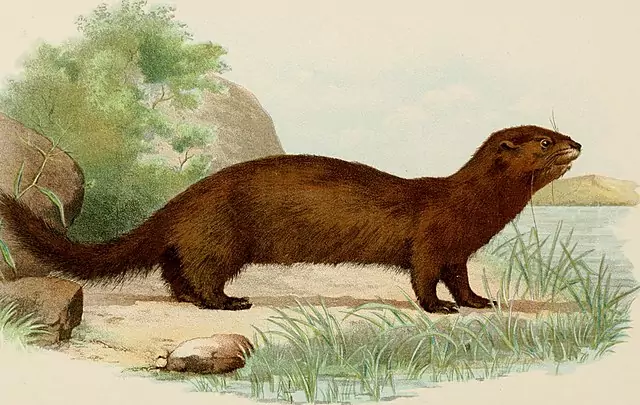A species known as the sea mink (Neogale macrodon) went extinct in Maine only 150 years ago. Never heard of it? You’re not alone. Most Mainers haven’t.
Though it held immense cultural significance for indigenous communities (called supeqi-ciyahkehsuwok, or saltwater mink in Passamaquoddy) and European fur traders before its extinction, it has since been forgotten. And scientists want to know why.
How different was the sea mink from the still-living American mink? What does its extinction mean for the coast of Maine today?
Today, all that remains of the sea mink are its bones and teeth, found in the thousands of archaeological sites that dot the coast of Maine…
The sea mink, once found from the Isles of Shoals in New Hampshire to New Brunswick, went extinct in the mid-1800s due to over harvesting for their fur. Twice the size of today’s American mink (their closest living relative), the sea mink was highly desired for its expensive pelt. Reddish in color, it smelled like the fish it hunted. The sea mink lived in rock dens along the shore and spent most of its time hunting in the frigid ocean water or sleeping in dens.
Brewer fur buyer Manly Hardy described in a 1903 report to the Smithsonian Institution how the mink were hunted. Rather than being trapped as mink are today, sea mink were prodded out of their dens with crowbars or dogs and then shot.
During the 1800s, the popularity of mink coats in Europe and America soared. Depending on size and style, one coat required 60-200 individual minks. Being twice the size of interior minks, the sea mink’s pelt cut this number in half, which made them the preferred quarry.
Hardy reported that: “In the old days, when mink were judged by size instead of fineness and color … these mink used to bring considerably more than others on account of their great size. On this account they were persistently hunted.”

Hardy also noted that “As the price of mink rose, they were hunted more and grew scarcer, till in the [1860s], when minks brought $8 or $10 apiece, parties who made a business of hunting nearly or quite exterminated the race.” Today, all that remains of the sea mink are its bones and teeth, found in the thousands of archaeological sites that dot the coast of Maine known as shell heaps (or middens).
Archaeologist Dr. Bonnie Newsom (University of Maine) leads excavations at a site near Machias as part of the University of Maine archaeological field school. These huge shell heaps—piles of shells left behind after shellfish were harvested—were created by the ancestors of Wabanaki people, of whom Newsom is a descendant.
Common items found in middens include stone tools, charcoal, potsherds, and animal bones, including those of the sea mink. In the early 1900s, archaeologists noticed that the sea mink was huge—twice the size of American mink. And while some believed the sea mink is a distinct species based on its teeth and bones (signifying what it ate and how it lived), others believed that the differences between sea mink and American mink were not enough to call them a new species.
Today, a group scientists and community members supported by the National Science Foundation are working to understand the role the sea mink played in Maine and what its extinction meant for the coastal ecosystems. By combining genetic information from the bones found in shell heaps with chemical information about diet, bone and tooth size, historical documents, and modern ecological knowledge, the collaborators are unraveling the sea mink’s mysterious life and extinction.
As an islander myself, I care deeply about the human and non-human communities that call the coast home. I hope the story of the sea mink will inspire my neighbors to learn about the world around them and to prevent future coastal extinctions.
Olivia Olson is a graduate student at the Climate Change Institute at the University of Maine working under the supervision of Dr. Bonnie Newsom studying the zooarchaeological record in Acadia National Park. She grew up on Islesboro and spent her college career in Vermont before returning to Maine.





